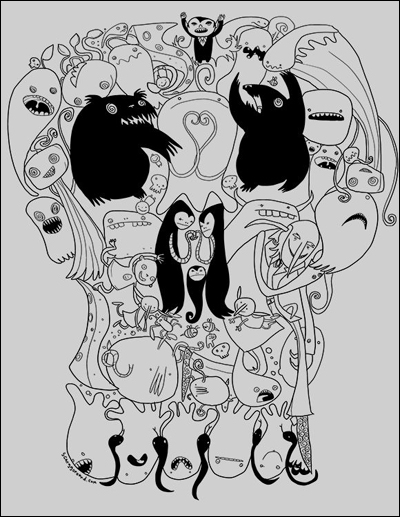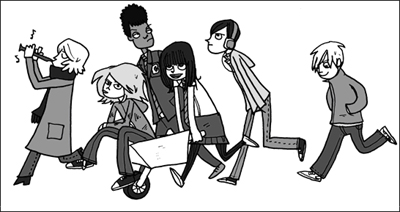VADER AND I (Withnail/Star Wars Mashup)
Huzzah! Another geeky, ask boozy weekend treat for us– the words of Withnail and I, purchase filtered through the space epic lenses of Star Wars:
Via Mildred Von, ta!
Huzzah! Another geeky, ask boozy weekend treat for us– the words of Withnail and I, purchase filtered through the space epic lenses of Star Wars:
Via Mildred Von, ta!


Still from this short by G7D.
The UK-based, world-traveling artist Hush has returned to LA with his show “Twin”, opening tomorrow (Saturday) at New Image Art. Hush’s work explores and pushes the porous boundaries between graffiti, street art, tagging, anime and pop art.
From his bio:
Hush’s work has been described as a sensory assault of shape, color, and character. Inspired by the portrayal of the female form in art, the artist builds up and tears down layers of paint and images as he works, “letting the canvas and marks take their own path.” The result is an enigmatic synthesis of anime, pop-infused imagery and graffiti that exposes the conflict between power and decay, innocence and sexuality, and the fusion of Eastern and Western culture. Hush continues to evolve his style with this latest batch of pieces, which merges his early anime and pop-art influenced graffiti technique with an exploration of Romanesque iconographic imagery.
Via My Love For You, via Siege.

‘Together I’ 2011

Via DJ Dead Billy, thanks!
Designed and built by the architecture team of Tonkin Liu and completed in 2006, this award-winning sound sculpture called The Singing Ringing Tree stands atop a plateau in the Pennine mountain range overlooking Burnley in Lancashire, England. It’s one of a series from the Panopticons arts and regeneration project.
Galvanized steel pipes of various sizes are bound together in a nine-foot-tall, spiraling configuration. Depending on where and how the wind strikes it, The Singing Ringing Tree creates discordant choral sounds over a range of several octaves. Tonkin Liu tuned the pipes “according to their length by adding holes to the underside of each.” The eerie music created as a result is capable of ringing out across great distances.

Photo by Felix Spencer


British actress Elisabeth Sladen has died at the age of 63, after battling cancer. Sladen played Sarah Jane Smith on the cult classic BBC television series Doctor Who. Over time, her character grew to become one of the most beloved of all the Timelord’s companions.
Sladen was on a short list of people who became deeply involved with the new Doctor Who program in addition to the old one, so much so that Sladen eventually starred in a multi-season, award-winning spin-off series of her own, a program geared towards teen audiences called the Sarah Jane Adventures, which introduced a new generation of viewers to Sarah Jane and her darling robotic sidekick, K-9.
An adorable and windblown Ms. Sladen bounds through the opening credits of the 1981 pilot for a proposed BBC series, K-9 and Company. “Sometimes good television doesn’t depend on money. It depends on imagination and good people directing, casting and doing the job with talented people. Then you’re forgiven a great deal, I think, if sometimes something doesn’t look quite on the money.” ~Elisabeth Sladen
Earlier this evening, in England, Sladen’s friend and fellow Doctor Who revivalist, Russell T. Davies, paid tribute to the woman and her character in conversation with the BBC:
“We found ourselves with a new friend… as we shot that episode I remember thinking ‘I’m not letting her go’.”
R.I.P.


Turn off all the lights, get under the covers, put on your best pair of headphones, and listen… if you dare:
Via Aaron Shinn (whose own fantastic work definitely deserves a Coilhouse writeup ASAP).
Demdike Stare is an occult-tinged music collaboration between Miles Whittaker and Sean Canty, two highly knowledgeable fellows from Manchester, each with a versatile background in DJing, record collecting and curating. Author Mike Powell’s review of Demdike Stare’s Triptych –one of the most interesting write-ups Pitchfork has posted recently– covers Whittaker’s and Canty’s work and history, both as a team, and separately. From that same review:
Demdike Stare is primarily a sample-based project, and “dark” is its organizing principle. Their logo is a skull, rose, and triangle; the cover of one of their EPs is a visual riff on a Ouija board; and they’re named after a 17th-century witch– a quasi-gothic, English variation on the sci-fi and horror imagery that has saturated the American underground over the past couple of years. The tracks on Tryptych are droning and nightmarish: lots of close murmuring and distant wind, lots of groaning earth and quietly whining steam-powered machines, glassy techno keyboards and the buried wailing of undefined tribes. But like some drone (and most minimal techno) there’s usually a build or a climax, and one of the most consistently satisfying things about listening to Tryptych is that it takes music you might expect to be purely ambient and shapes it into something with a hump somewhere in the middle– something with a narrative to it.

Cover for Demdike Stare’s Forest of Evil EP. Buy their CDs and MP3s at Amazon or Insound.
There’s a captivating visual element to Demdike Stare as well– to accentuate their live shows, the band often projects footage lifted from a wide range of classic horror and giallo films, spaghetti westerns, and thrillers onto the wall behind them, then mixes live beats and samples into their tracks to match those visuals. Additionally, Demdike Stare’s listeners have come up with with several captivating fan videos, many of which are included in the above playlist [and are not entirely SFW, mind you], along with a great interview with Whittaker and Canty, for those interested in learning more about the team’s process. Or, if you’d prefer to keep things more mysterious, skip the interview, and just let yourself be swept away by the enigmatic loveliness of the music and presentation.
Previously on Coilhouse:


Art by John Allison
Devoted and cultish readers extol John Allison as “a rare gem in the often hard-to-navigate web comic underbelly.” Though you may not presently be reading John Allison’s current endeavor, Bad Machinery, chances are that you are perhaps already familiar with him through his older works, Scary Go Round (2002-2009) or Bobbins (1998-2002), or as an artist/chum linked to through one or more of his contemporaries.
Fans of Jeffrey Rowland’s Overcompensating for example, will recognize Allison as “The Englishman” , a British gentleman of dubious distinction who occasionally happens upon the scene to politely antagonize the regulars. Or, through Dumbrella Collective alum, R. Stevens, mastermind behind Diesel Sweeties and 8-bit illustrator of our charming editrixes here at Coilhouse. Maybe even through one of the dynamic guest strips he has provided over the years to one of your long-time favourite web comic artists.
Marked by clever, peculiar dialogue, absurdist humor, dotty characters (and delightful ladies fashion!), mysterious happenings and hi-jinks, and a dense mythology (though compelling and completely addictive, to which anyone who has begun to peek through his archives can attest) – John Allison’s story-telling genius is unmistakable. And in a medium where visuals are the reason most viewers show up in the first place, the exquisitely charming, highly stylized art is “as big a draw as the comedy”.

Scary Go Round, “Bulgaria”
Described as “postmodern Brit horror”, Allison’s previous comic, Scary Go Round followed the hapless denizens of Tackleford, a fictional British town beset by all manner of supernatural activity including, but not limited to: zombies, space owls, the devil, and portals to other dimensions. Though Scary Go Round ended in 2009, a few of his beloved characters have moved on to Bad Machinery, which picks up in Tackleford 3 years later. The focus is on an entirely new cast of sleuthing schoolchildren attending Griswald’s Grammar School, whose well-intentioned energies may be causing more problems than the mysteries they solve – but they throw themselves into it all with much vigor and aplomb.

Bad Machinery Flyer Art for Thought Bubble
Coilhouse recently caught up with John Allison about his new endeavor; see below the cut for our Q&A in which John talks about the transition between old stories and new, the state of web comics today, and the meaning behind the monsters.


Neck not supporting head? Eyes won’t focus? Daily grind? Sausage grind? Welcome, sons and daughters. Welcome to the machine. Specifically, the infamous Bagger 288:
0:47 = tragically accurate visual metaphor for the author’s current state.
Yep. An internet classic. When in doubt (or too sleep deprived to think straight), Joel Veitch to the rescue!

Setting the scene: it’s a balmy late afternoon in downtown Los Angeles, summer of 2010. An amazing feature opportunity has suddenly presented itself, bringing Zoetica and I together for an impromptu interview/photo shoot at the Standard Hotel— a populuxe wet-dream of a place with Jenny Holzer art and an imitation Calder mobile in its lobby. Our esteemed subject has agreed to meet us for a drink at the Googiegasmic 24/7 Restaurant on the ground floor.

Photo by Zoetica Ebb.
Later in the evening, he’ll ride an elevator up to the swanky retro Rooftop Bar to DJ a killer set of “hyper lounge” for the likes of Sasha Grey, Mildred Von, the director of Lip Service, Miyu Decay, Andy Ristaino, Courtney Riot, and a slew of soused software convention-goers. But for now, he’s holding court at our corner table, and he’s got Zo and me doubled over in helpless fits of laughter. As our cackling reaches a crescendo, fellow patrons look up from their $20 cheeseburgers in confusion. Perhaps this pale, slim, soft spoken and immaculately dressed Englishman with the barest hint of a smile on his face isn’t the instigator they expected. One thing’s for sure: David J Haskins surprised the hell out of us! Delightfully so.

David J in the lobby of the downtown LA Standard Hotel. Photo by Zoetica Ebb.
As Zo sets up her next shot, I sip my coffee and ask the man who wrote the lyrics for Bauhaus‘ seminal song, “Bela Lugosi’s Dead” if vampirism is, in fact, the secret to his youthful appearance. “I’m actually very wrinkled from the waist down,” he says. Hastily, I wipe up my spit take. “Don’t print that.” Zo insists that we should print that. “Oh, all right. You can print that.” A few minutes later, he launches into an anecdote about “the infamous pan-flute monkey” from Love and Rockets’ music video for ‘No New Tale to Tell’: “The handler put peanuts down all of the pipe shafts.” The idea being that the monkey would try to tip them out to eat and appear to be playing the flute. “Worked out pretty well. But when the little bugger wasn’t trying to get at the peanuts,” (David J’s voice drops to a conspiratorial whisper) “he was wanking. Endlessly. For hours. Hours and hours. And staring at us.” Zo does her best to keep the camera steady. “It was quite impressive, actually! And a little terrifying. No one wanted to go near the filthy thing.”
Giggle fits notwithstanding, professionalism prevails. Zo gets some great shots, and in of spite being uncharacteristically twitterpated (can’t be helped; I smoked my very first clove while listening to “Who Killed Mister Moonlight“), I’m able to nab an in-depth, thoughtful interview from a most multifaceted and influential progenitor of post-punk alternative culture.

David J, making mischief at the Standard Hotel’s 24/7 Restaurant. Photo by Zoetica Ebb.
It’s hard to know where to begin with you! The range and diversity of the creative projects you’ve been involved with for over the course of your career is astounding. In addition to being a musician and a lyricist, you’re a visual artist, playwright … and more recently, you’ve even gotten into screenwriting?
Just in the last year, yes. I embarked on that with a partner, Don C. Tyler, and we have a fantastic chemistry. So far it’s going very well, it’s picking up. We have a couple of different scripts in the works. I am actually contracted not to talk about the subject matter of either of them, sorry, but I can tell you they’re tangentially connected. And yes, I’ve written some plays. I was going to say I just finished my second play, but really it’s the third, because initially, I got into writing for the stage after creating this 12-minute play about punk rock called Anarchy In The Gold Street Wimpy. It had never occurred me to write one before, but my publicist, Versa Manos, was friends with this theatre company in Atlanta, Georgia, called Dad’s Garage. They were looking for submissions for a theatrical presentation of short 12-minute plays based on the idea of punk rock. She suggested I should have a go at it, and so I did. I thought, well, I was there, after all. Going to shows in 1976, when punk rock was full-on.


A preface for the unfamiliar, potentially aghast reader: the English Victorian taxidermist Walter Potter was, according to all accounts, a gentle and kindhearted man. (Read more about him here, and here.) All the animals Potter used in his work were said to have died of natural causes. Apparently, he never harmed any creature presented in his displays. Rather, he arranged to take carcasses off the hands of a local farm and veterinarian. Additionally, as his reputation grew, the community he lived in began to donate expired critters.

Bride from “Kitten’s Wedding”
Today, many perceive his elaborate anthropomorphic dioramas –featuring various dead animals: kittens, puppies, rabbits, ducks, squirrels, frogs, etc, imitating domestic human life– as grotesque, but bear in mind that at the time they were made, and for many decades following, the creatures in Potter’s vast collection were well-admired as an elegant source of “Victorian whimsy”.
Long after Potter’s death, crowds still came to view his thousands of creatures at the Potter Museum in Bramber, Sussex, England. (Then, later, at Cornwall’s Jamaica Inn.) However, sensibilities change. By the end of the 20th century, fewer and fewer devotees were making the pilgrimage to see Potter’s body of, well, bodies. The vast collection was finally dismantled and sold off in bits and pieces in 2003, to a wide array of buyers, for roughly £500,000.

“Rabbit and Hen”
“It caused outrage when John and Wendy Watts split up and sold the historic dioramas. […] Artist Damien Hirst, a huge fan of Walter Potter’s work, said he would have paid £1 million to keep the collection together.” Now, eight years later, many of the pieces have been reassembled in an exhibition at the Museum of Everything in Primrose Hill, London. Co-curators James Brett and Peter Blake did their best to retrieve as many of the dioramas back on loan as they could. Opening today, the gallery showing includes several of Potter’s most famous pieces: “The Death of Cock Robin,” The House that Jack Built”, and “Happy Families”.

“A Friend In Need”
Unsqueamish Coilhouse readers in the UK/Europe, don’t miss this rare opportunity to see Potter’s fascinating work in person! (It runs through December.) Please be sure to report back. Several more images after the jump.



“I’m a little teapot…” By Charles Krafft. As seen on LAShTAL.
Quiver and quail, Thelemites, for Τὸ Μεγα Θηρίον‘s whelping day is upon us. What better way to acknowledge the degenerate rice-cooker than with one of David Tibet‘s crowning musical/lyrical achievements, a magickal rap ditty called “Crowleymass Unveiled”?
File this one under the ultra specific hybrid category of “Can’t believe this actually exists/Can’t stop laughing.” Along with this. Also, this.
Full “Crowleymass” lyrics posted after the jump.

